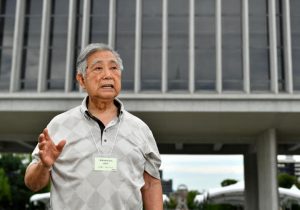Summer following conclusion of Hiroshima Summit—In his 90s, Mikio Saiki, of Hiroshima’s Naka Ward, decides to share A-bomb experience
Aug. 4, 2023
Outraged at Russia’s threats to use nuclear weapons
by Kaori Ota, Staff Writer
One A-bomb survivor, now older than 90, has decided for the first time to communicate his experience on the day of the atomic bombing. Mikio Saiki, 91, a resident of Hiroshima’s Naka Ward, experienced the atomic bombing as a second-year student at First Hiroshima Prefectural School (present-day Hiroshima Kokutaiji High School). This year, Mr. Saiki volunteered to speak of his experience in the atomic bombing in a so-called “A-bomb witness” program organized by the Hiroshima City government. His action was partly prompted by Russia’s invasion of Ukraine. Mr. Saiki now feels the importance of conveying the voices of the A-bombed city of Hiroshima because of Russia’s repeated threats to use nuclear weapons. He voiced his determination to testify of his experience with an eye to the future. “As long as I’m alive, I want to speak about my A-bomb experience for those who died in the atomic bombing.”
“I used to think about how I have to communicate my experience in the atomic bombing someday, but I didn’t actually want to remember,” explained Mr. Saiki, who said he has continued to live with emotional conflict about the issue. After he saw the nuclear superpower Russia launching its military invasion last year in February, he made the determination to speak about his memories of that day 78 years ago, which he had long kept to himself. Mr. Saiki was outraged. “Nuclear weapons must never be used to threaten.”
On the morning of August 6, 1945, Mr. Saiki, then 13, experienced the atomic bombing at his home in the area of Danbaranaka-machi (now part of Minami Ward), 2.2 kilometers from the hypocenter. His entire family survived the bombing, but “everything was destroyed as far as I could see.” People blinded and with faces disfigured by swelling roamed the city in search of water.
Mr. Saiki described how one of his classmates had asked him to go to school the following day and how on their way they had witnessed “hellish scenes.” He said, “Rows of dead bodies were lined up on a mountain.” In First Hiroshima Prefectural School, 353 students, including those mobilized for the war effort to help demolish houses for the creation of fire lanes, died in the bombing. “I survived because I had the day off,” said Mr. Saiki, with lingering mixed feelings.
To date, Mr. Saiki has sealed off his A-bomb experience, preferring not to talk about that time. However, given the present international circumstances, in which a nuclear weapon could be used in war for the third time in human history, he determined to convey his A-bomb experience to future generations as an “A-bomb witness.” Saiki attended training sessions of the Hiroshima City program, which was initiated by the local government in July. He began to work on the draft of a presentation with the aim of debuting as a speaker sometime next year. “I might only have four or five years remaining to talk about my A-bomb experience,” he explained, expressing his intent to speak out with all his strength as long as he is alive.
The president of Ukraine, a country now at war, visited Hiroshima and called for solidarity among G7 nations (Group of Seven industrialized nations) at the G7 summit meeting held in May in Hiroshima City. Meanwhile, Russia continues to hint at its possible use of nuclear weapons. As the world situation grows more and more volatile, Mr. Saiki implored G7 leaders, “Inhumane nuclear weapons must never be used. You should take nuclear abolition more seriously.”
(Originally published on August 4, 2023)







